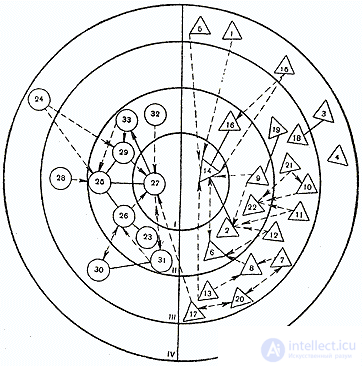Lecture
One of the most popular methods for determining interpersonal relationships in a group is sociometry proposed by Freud's student, Jacob Moreno (1889-1974). According to the theory of J. Moreno, all tensions, conflicts, including social ones, are due to the discrepancy between the micro and macro structures of the group. This discrepancy, in his opinion, means that the system of sympathies and antipathies, which shows the psychological attitude of the individual towards people, often does not fit into the framework of a given individual macrostructure: the closest possible psychological environment is unacceptable. The challenge is to align the macro and microstructure. It is for this purpose that a sociometric method should be applied, with the help of which one can explore likes and dislikes in order to make certain changes in accordance with the results obtained.
The term “sociometry” literally means “social dimension,” a sociometric method designed to assess interpersonal relations of an informal type: likes and dislikes, attractiveness. Having the character of a poll, sociometry differs significantly from a questionnaire survey and an interview in that the questions relate to the emotional sphere of people's relationships.
The sociometric procedure is that the group members are offered to list in order of preference those comrades in the group with whom they would like to work together, relax, sit at a desk and the like. Questions about the desire of a person to participate in a certain activity together with someone are called selection criteria.
For example, “Who would you like to prepare for the exam together?” Or: “Who would you invite to your birthday?”, Etc. The success of the study of relationships depends on the proper selection of these issues. There are weak and strong selection criteria. The more important for a person this or that activity, the closer and longer the communication it provides, the stronger the selection criterion is considered. Most often, a sociometric study combines different types of questions. They get in such a way as to reveal the desire of a person to communicate with members of a group in various activities - in work, study, rest, friendship, and the like.
When planning sociometry, one should decide the quality and number of criteria used, as well as the number of choices that each member of the group will make and their intensity to a greater or lesser extent. Most often the number of choices is limited to three.
The results obtained using the sociometric procedure can be represented graphically in the form of a sociogram, matrix, and special numerical indices.
The tables of results of sociometry are filled first of all, besides separately for business and personal relationships.
Vertically recorded by the names of the names of all members of the group that is being studied; horizontally - only their number. At the corresponding intersections, the numbers 1, +2, +3 designate those who have been selected by each person studied in the first, second, third turn, by the numbers 1, 2, -3 - those the subject does not select in the first, second and third queues.
Mutual positive or negative choice is circled in the table (regardless of the order of choice). After the positive and negative choices are entered into the choices received by each member of the group (the sum of the choices), then the sum of points for each member of the group is calculated taking into account that the choice is first of all equal to +3 points (-3), the second - 2 (-2), in the third - 1 (-1). After that, the total algebraic sum is calculated, which determines the status in the group.
Group cohesion is calculated by the formula
 ,
,
where ∑ is the sum of all mutual elections in the group; n is the number of group members.
The cohesion of the group is the higher, the closer to unity the cohesion coefficient.
Based on the data of sociometric analysis, conclusions are drawn about the level of group cohesion; the presence of groups; their connections with leaders; about the interaction of leaders among themselves; the match of the selected asset to the real presence of group members who are not accepted by the group and isolated.
| No | Surname | one | 2 | 3 | four | five | 6 | 7 | eight | 9 | ten |
| one | Abalkin | +1 | +2 | +3 | -one | ||||||
| 2 | Estorsky | +1 | +3 | +2 | |||||||
| 3 | Kammerer | -one | +1 | +2 | +3 | ||||||
| four | Bromberg | +2 | +1 | +3 | |||||||
| five | Glumova | +2 | +1 | +3 | -3 | -2 | |||||
| 6 | Sikorsky | ||||||||||
| 7 | Athos-Sidorov | +1 | +3 | ||||||||
| eight | Scheck-Itrch | +1 | +3 | +2 | |||||||
| 9 | Horn | +2 | +1 | +3 | -one | ||||||
| ten | Repnin | +2 | +1 | +3 | -one | ||||||
| Number of choices | |||||||||||
| Number of points | |||||||||||
| total amount |
Sociogram is a graphic representation of the results obtained using a sociometric method in the study of interpersonal relations. It gives a visual representation of the intragroup differentiation of members of a small social group for their status (popularity). With the help of special signs and arrows indicate the type of choice (positive, negative, one-sided, two-way).
Sociogram clearly shows the central, most influential members of the group, mutual pairs and groups of interconnected individuals choosing each other. Most often in sociometric results there are positive groupings of 2-4 members.

Comments
To leave a comment
Mathematical Methods in Psychology
Terms: Mathematical Methods in Psychology